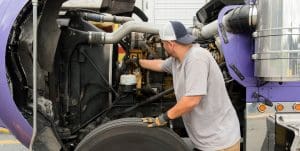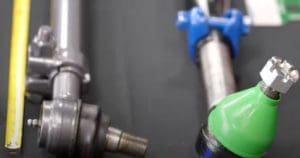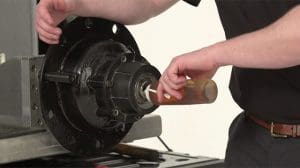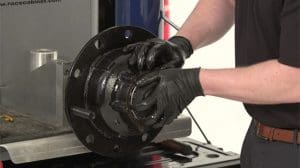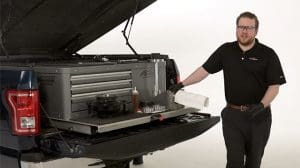Según la American Trucking Associations (ATA), la asociación comercial nacional más grande de la industria del transporte por carretera, actualmente hay una escasez de más de 78.000 camioneros en las carreteras diariamente. Peor aún, la ATA también estima la necesidad de contratar alrededor de 1,2 millones de nuevos conductores durante la próxima década para satisfacer la creciente demanda de carga y reemplazar a aquellos que abandonan el transporte por carretera, ya sea por jubilación u otras razones.
No es algo que deba tomarse a la ligera, pero todavía hay esperanza. En todo caso, la situación sirve como una buena oportunidad para que los administradores de flotas se conecten con sus mecánicos y técnicos para encontrar formas de ayudar mejor a sus conductores. También destaca la importancia de que las flotas se mantengan proactivas a la hora de ofrecer el tipo adecuado de oportunidades de formación para prepararse para el camino que les espera.
Mark S. Allen, presidente y director ejecutivo de la Asociación Internacional de Distribuidores de Servicios de Alimentos (IFDA), lo dijo bien: “Los últimos tres años han demostrado cuán importantes son los camioneros para la economía y el estilo de vida estadounidenses, y con qué urgencia necesitamos desarrollar una cartera de conductores profesionales calificados y bien capacitados para satisfacer las crecientes necesidades de carga de nuestra nación”.
Creciendo la fuerza laboral
La ATA calcula esta estimación de escasez actual comparando la diferencia entre los conductores activos en el mercado ahora y el número óptimo de conductores según la demanda de carga. Aunque la solución parece bastante sencilla (simplemente contratar más conductores), es mucho más profunda que un juego de números.
De hecho, el economista jefe de ATA, Bob Costello, dice que en el centro de la escasez está esta extrema necesidad de conductores calificados:
“Los transportistas dicen repetidamente que no es que no tengan suficientes candidatos para sus puestos vacantes, sino que los tienen. Lo que no tienen es suficientes candidatos que cumplan con las exigentes calificaciones para ser contratados. En algunos casos, los transportistas deben rechazar el 90% de los solicitantes de plano porque no cumplen con al menos uno de los requisitos previos para conducir en el comercio interestatal”.
En otras palabras, estar a la altura de este desafío actual requerirá una inversión significativa en tecnología, capacitación y seguridad para satisfacer las demandas de contratación y retención.
Equipar a la fuerza laboral
Cuando se trata de la necesidad de encontrar conductores o trabajadores “cualificados”, está claro que las empresas tendrán que priorizar iniciativas de formación que puedan atraer y retener talentos más jóvenes y prometedores. A este desafío se suma la realidad de que la edad también es ahora un factor que contribuye a la escasez actual. De hecho, la Oficina de Estadísticas Laborales de EE. UU. estima que el conductor de camión estadounidense promedio tiene 55 años, lo que presenta otro enigma que las empresas deben resolver: ¿pueden los propietarios y administradores de flotas lanzar un esfuerzo de colaboración con sus conductores experimentados para aprovechar al máximo esta situación? situación y brindar la tutoría, orientación y apoyo necesarios a la próxima generación de trabajadores?
Atraer y retener conductores cualificados
Si bien las oportunidades de capacitación son un poderoso atractivo, las empresas también pueden atraer conductores dependiendo de la calidad de los componentes y equipos ofrecidos. Es más probable que los conductores elijan empresas que inviertan en flotas más nuevas para proporcionarles piezas y maquinaria confiables. Al priorizar el mantenimiento y la conservación de sus camiones, las empresas pueden aliviar cualquier preocupación que los conductores puedan tener sobre las reparaciones frecuentes o posibles problemas mecánicos futuros. Al comparar las opciones disponibles, esa es una forma de hacer que su flota se destaque de la competencia.
En segundo lugar, las empresas que invierten en tecnología y soluciones de datos inteligentes, como dispositivos de registro electrónico (o ELD), ofrecen a sus conductores y trabajadores operaciones más eficientes y optimizadas. Estos productos pueden ayudar a realizar un seguimiento de la mayoría de las actividades diarias de los conductores, al mismo tiempo que monitorean los hitos clave de mantenimiento de los vehículos de la flota. Elegir implementar pasos como estos puede eliminar una gran cantidad de papeleo adicional tanto para los conductores como para los mecánicos.
Nuestro Tecnología de vehículos STEMCO (SVT™) Los productos utilizan tecnologías inteligentes para simplificar los procedimientos de mantenimiento, agilizar la recopilación de datos y mejorar la seguridad general de la flota. Los hubodómetros DataTrac® SVT™ envían una señal Bluetooth que es leída por un GateReader fijo en el patio de la flota o por la aplicación Fleet Manager en un teléfono móvil. Esto elimina los errores que a menudo ocurren cuando se recopilan a mano, un método tedioso propenso a errores humanos, que puede demostrar que los datos no son confiables e incluso generar problemas mayores en el futuro.
STEMCO U: Nuestro Compromiso con la Capacitación
En STEMCO, trabajamos arduamente para brindar capacitación de primer nivel como parte de nuestro compromiso de Hacer las carreteras más seguras®. A medida que los componentes y sistemas de transporte modernos se vuelven más complejos y la necesidad de protegerse contra responsabilidades se vuelve más crítica, STEMCO se esfuerza por brindar a la industria valiosas oportunidades de aprendizaje. STEMCO U es nuestro programa de capacitación interno en línea diseñado para satisfacer las crecientes necesidades del mercado de vehículos comerciales. Aunque nuestro contenido está más orientado a mecánicos y técnicos que a conductores, creemos que si los técnicos están mejor capacitados, estarán mejor equipados para mantener los camiones funcionando sin problemas, lo cual es un beneficio directo para los conductores.
Aquí hay una breve descripción de nuestras ofertas:
- Cursos en vídeo en línea que cubren una amplia gama de temas, desde la instalación del producto hasta el mantenimiento y la optimización de la eficiencia.
- Aprende a tu propio ritmo, en tu propio tiempo, desde cualquier parte del mundo.
- Realice un seguimiento de su progreso y reciba certificados de finalización personalizados e imprimibles al aprobar los cursos.
- STEMCO U fue desarrollado para ayudar a satisfacer la creciente demanda de información precisa y confiable sobre procedimientos adecuados de instalación y mantenimiento.
Contáctenos
Este es un problema complejo al que se enfrenta nuestra industria y que nos tomamos muy en serio. Lo mejor que puede hacer es mantenerse proactivo y trabajar para profundizar las herramientas, los beneficios y las oportunidades de capacitación que su empresa puede ofrecer durante este tiempo para ayudar a prepararse para el camino por delante. Si tiene preguntas o desea obtener más información sobre lo que tenemos para ofrecer a través de STEMCO U, no dude en Contáctenos.



